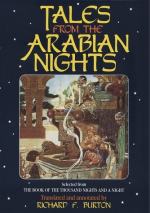12. More New Arabian Nights. The Dynamiter.
By R. L. Stevenson
and Vander Grift (London,
1882). Class 4.
Of these tales, Sir R. F. Burton observes, “The only visible connection with the old Nights is in the habit of seeking adventures under a disguise. The method is to make the main idea possible and the details extravagant. In another ’New Arabian Nights,’ the joint production of MM. Brookfield, Besant and Pollock, the reverse treatment is affected, the leading idea being grotesque and impossible, and the details accurate and lifelike.”
C.—German.
It is quite possible that there are many imitations in German, but I have not met with them. I can only mention one or two tales by Hauff (the Caliph turned Stork, and the Adventures of Said); a story called “Ali and Gulhindi,” by what author I do not now remember; and some imitations said to be by Grimm, already mentioned in reference to the English composite edition of 1847. They are all European fairy tales, in an Eastern dress.
CONCLUSION.
Among books specially interesting to the student of The Nights, I may mention Weil’s “Biblische Legenden der Muselmaenner, aus arabischen Quellen zusammengetragen, und mit juedischen Sagen verglichen” (Frankfort-on-Main, 1845). An anonymous English translation appeared in 1846 under the title of “The Bible, the Koran, and the Talmud,” and it also formed one of the sources from which the Rev. S. Baring-Gould compiled his “Legends of Old Testament Characters” (2 vols., 1871). The late Prof. Palmer’s “Life of Haroun Al-Raschid” (London, 1881), is not much more than a brief popular sketch. The references to The Nights in English and other European literatures are innumerable; but I cannot refrain from quoting Mark Twain’s identification of Henry the Eighth with Shahryar (Huckleberry Finn, chap. xxiii).
“My, you ought to have seen old Henry the Eighth when he was in bloom. He was a blossom. He used to marry a new wife every day, and chop off her head next morning. And he would do it just as indifferent as if he was ordering up eggs. “Fetch up Nell Gwynn,” he says. They fetch her up. Next morning, “Chop off her head.” And they chop it off. “Fetch up Jane Shore,” he says; and up she comes. Next morning, “Chop off her head.” And they chop it off. “Ring up Fair Rosamun.” Fair Rosamun answers the bell. Next morning, “Chop off her head.” And he made every one of them tell him a tale every night, and he kept that up till he had hogged a thousand and one tales that way, and then he put them all in a book, and called it Domesday Book—which was a good name, and stated the case. You don’t know kings, Jim, but I know them, and this old rip of ourn is one of the cleanest I’ve struck in history. Well, Henry, he takes a notion he wants to get up some trouble with this country. How does he do it—give notice?—give the country a show? No.




